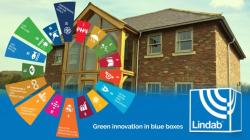How Lindab rainwater systems contribute to the UN sustainable development goals
 Lindab have made no secret of our commitment to sustainability with the mission statement, “For a better climate” setting the standard for the approach that is expected in every aspect of the organisation. This means that Lindab have examined every way that we work; ensuring our sourcing practices are ethical; making systematic changes to improve our workplace; investing in reducing energy consumption for operations; and a wide range of other activities for sustainability.
Lindab have made no secret of our commitment to sustainability with the mission statement, “For a better climate” setting the standard for the approach that is expected in every aspect of the organisation. This means that Lindab have examined every way that we work; ensuring our sourcing practices are ethical; making systematic changes to improve our workplace; investing in reducing energy consumption for operations; and a wide range of other activities for sustainability.
Most importantly, we recognise that the products we make go on to be in buildings which will exist within the world for a long time. Lindab provide environmental and quality certifications and Environmental Product Declarations for many of our products and systems for building owners and those involved in construction, to enable you to make more informed decisions about sustainable solutions.
The 2030 Agenda for Sustainable Development, adopted by the United Nations provides 17 Sustainable Development Goals which represent areas for action. We can demonstrate how Lindab rainwater system, Rainline contributes to a number of the UN SDGs.
Goal 17: Partnership for the goals
Lindab is committed to using steel suppliers that prioritise sustainable development towards fossil-free steel with minimum carbon dioxide values. Our highest contribution to greenhouse gas emissions comes from using steel, so we're transitioning to fossil-free steel, a significant action to reduce our environmental impact. We're partnering with SSAB and H2 Green Steel to access CO2-reduced steel by 2026, which we'll use in a new green product line. This aligns with UN Sustainable Development Goal 17, emphasising partnerships for sustainable development.
Goal 6: Clean water and sanitation
Lindab Rainline is a sustainable system for rainwater drainage that has a service life of 60 years and is made with recyclable material. By using Lindab Magestic which has a newly developed and more advanced rust protection than normal galvanised steel, Lindab is contributing to the sustainability goal of clean water and sanitation. This includes improving water quality, wastewater treatment, and safe reuse.
Goal 11: Sustainable cities and communities
Steel is a highly versatile and widely used material, and Lindab is taking steps to make their products more sustainable. By using high-build polyester coated steel in our manufacturing, we are producing roofing products that are not only durable but also environmentally friendly. No hazardous waste is formed during production and the end products do not harm the environment. This aligns with UN Sustainability Goal 11, which aims to make cities and human settlements inclusive, safe, resilient, and sustainable.
Goal 12: Responsible consumption and production
By taking action to reduce our CO2 emissions by transitioning to fossil-free steel, Lindab will contribute significantly to responsible consumption and production Goal 12. Lindab considers the environmental impacts of its products throughout the manufacturing process, including the use of raw materials, packaging, fuels, and waste management. Lindab also minimises material loss during manufacturing and ensures traceability of its products. By prioritising sustainable production practices and materials, Lindab is supporting responsible consumption and production.
Goals 14 and 15: Life below water and life on land
Compared to PVC systems, Lindab steel guttering systems last about five times longer, which helps reduce waste and conserve resources. Additionally, a coloured PVC system may discolour over time, but the Lindab Rainline drainage system keeps its colour as it does not fade in the sun and is low maintenance. Lindab Magestic. contributes to less pollution in water systems or the soil due to having less than 25% zinc run off compared to hot dipped galvanised steel, aligning with UN sustainability goals 14 and 15. These goals aim to conserve and sustainably use the oceans, seas, and marine resources and to protect, restore, and promote the sustainable use of terrestrial ecosystems, sustainably manage forests, combat desertification, and halt and reverse land degradation and biodiversity loss.
Goal 9: Industry, innovation, and infrastructure
Lindab Rainline is a rainwater system designed to offer a combination of toughness, adaptability, and effortless installation while maintaining steel's low carbon dioxide footprint over its lifetime. Extensive tests have demonstrated that steel rainwater systems have the lowest carbon footprint compared to other materials. Lindab Rainline is made from up to 30% recycled materials and coated with high-build polyester, which increases its expected lifespan. Furthermore, steel is entirely recyclable, which means that its environmental impact is much lower than that of plastics and other metals. This aligns with UN sustainability goal 9, which aims to build sustainable infrastructure; promote inclusive and sustainable industrialization; and foster innovation.
Lindab’s commitment to producing sustainable products that are not only strong and long-lasting but also environmentally friendly aligns with the UN's sustainability goals. By incorporating innovative solutions like Bio-Based Technology (BT) coatings and using GreenCoat® colour-coated steel products, Lindab is helping to reduce waste and conserve resources. Their efforts towards sustainable production are building a better future for all.
Lindab develops, manufactures, markets and distributes products and system solutions for simplified construction and better indoor climate. The products are characterised by high quality, ease of assembly, energy and environmental thinking and come with a high level of service and support for increased customer value.